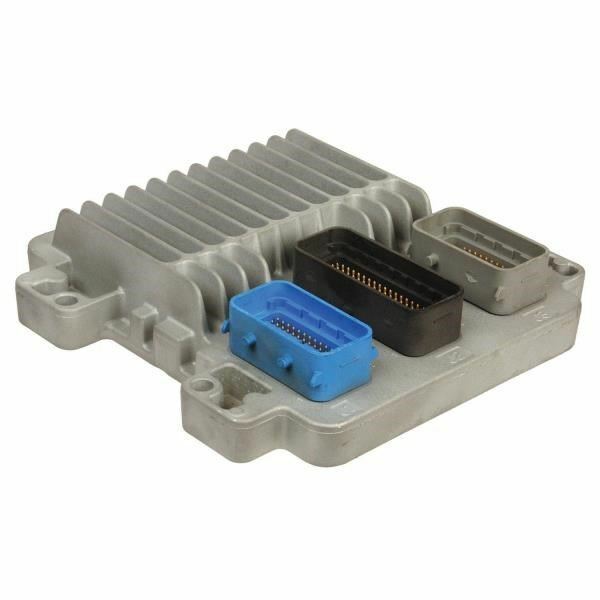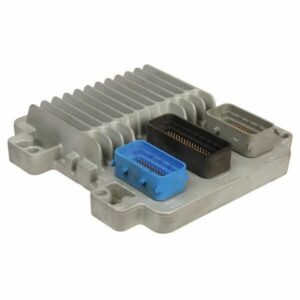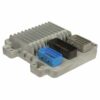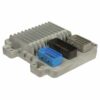Restore Peak Performance to Your GM Vehicle
As a technician with two decades of experience under the hood, I’ve seen firsthand how a failing Engine Control Module (ECM) can turn a reliable vehicle into a source of constant frustration. If your 2005 Envoy, Trailblazer, Corvette, or other compatible GM vehicle is suffering from a persistent check engine light, poor fuel mileage, stalling, or a no-start condition, the ECM is a primary suspect. This isn’t just a part; it’s the brain of your engine, and when it falters, everything else does too. This module is your direct, reliable solution.
We take the guesswork and dealer hassle out of the equation. This ECM, part number 12596771, arrives at your door pre-programmed with the latest official GM software updates. All we need is your vehicle’s VIN during checkout. This critical step ensures that the module communicates flawlessly with your specific vehicle’s systems—from the engine and transmission to the anti-lock brakes—restoring it to its original factory specifications. You’re not just buying a part; you’re getting a plug-and-play fix that saves you a costly trip to the dealership for programming.
Case Study: The Ghost Misfire
A customer brought in a 2005 Trailblazer with the 5.3L V8, complaining of an intermittent misfire that no one could solve. They had already replaced plugs, wires, and a coil pack, but the problem persisted, especially under load. Scans showed random misfire codes, but no specific cylinder was the culprit. After checking fuel pressure and for vacuum leaks, my gut pointed to the ECM. We ordered a VIN-programmed module just like this one. The installation took less than 20 minutes. On the test drive, the engine was smooth as silk. The old ECM had failing driver circuits that couldn’t consistently fire the coils under certain conditions—a classic ‘ghost’ problem solved by a reliable, correctly programmed 2005 Envoy XL ECM.
Is Your GM Vehicle Showing These Symptoms?
A faulty ECM can manifest in numerous ways. Over the years, I’ve seen these modules cause issues that mechanics might mistakenly attribute to other components. Here are the most common signs that your engine’s computer needs replacement:
- ✔ Persistent Check Engine Light (CEL)
- ✔ Engine stalling, stumbling, or hesitating
- ✔ Vehicle won’t start or is very difficult to start
- ✔ Noticeable decrease in fuel economy
- ✔ Failed emissions test
- ✔ Harsh or erratic automatic transmission shifting
- ✔ Common Diagnostic Trouble Codes (DTCs) stored, such as P0601 (Internal Memory Checksum Error) or P0606 (ECM/PCM Processor Fault)
A Straightforward Guide to Installation
Replacing the ECM on these vehicles is a job most DIYers can handle with basic tools. Because we program it beforehand, you can skip the expensive dealer visit. Here’s a typical process:
- Safety First: Always disconnect the negative terminal from your vehicle’s battery and wait at least 10 minutes for the system capacitors to discharge.
- Locate the ECM: On most of these trucks and SUVs (Envoy, Trailblazer, Rainier), the ECM is located on the driver’s side of the engine bay, near the firewall or fuse box. On the Corvette, it’s in the right-hand engine compartment. The SSR has it next to the air box.
- Disconnect Connectors: Carefully release the locking tabs on the electrical harness connectors and pull them straight out from the module. Never force them.
- Remove the Module: Unbolt the mounting bracket or screws holding the old ECM in place and remove it from the vehicle.
- Install the New ECM: Mount your new, pre-programmed 2005 Envoy XL ECM in the same location, securing it with the original hardware.
- Reconnect Everything: Firmly plug the wiring harnesses back into the new module until they click into place. Reconnect the negative battery terminal.
- Final Steps: Your vehicle may need to complete a security relearn procedure, which can often be done by cycling the key. Consult your owner’s manual for specific instructions if needed. Start the engine and enjoy a smooth-running vehicle!
Verified Vehicle Compatibility
This module is a direct replacement for service numbers 12578554, 12596771, 12597191, 12597883, and 19210071. It is guaranteed to fit and function correctly on the following 2005 models:
- Buick Rainier: 5.3L (LH engine)
- Chevrolet Corvette: (RH engine compartment)
- Chevrolet SSR: (next to air box)
- Chevrolet Trailblazer EXT: 5.3L (LH engine)
- GMC Envoy / Envoy XL / Envoy XUV: 5.3L (LH engine)
- Isuzu Ascender: 5.3L (LH engine)
- Pontiac GTO: Main (LH engine)
- Saab 9-7x: 8 cylinder (LH engine)
If you have any doubts about fitment, please send us a message with your VIN. We are here to ensure you get the right part for your vehicle, the first time. The right 2005 Envoy XL ECM is essential for a lasting repair.
Why do I need to provide my VIN?
Your Vehicle Identification Number (VIN) is essential for us to program the ECM with the correct software for your specific vehicle. This includes engine and transmission calibrations, emissions standards, and anti-theft system information, ensuring a perfect, plug-and-play installation.
Is this a difficult part to install myself?
For most DIYers with basic hand tools, this is a straightforward installation. Since the programming is already done, the physical swap is simple. The main steps are disconnecting the battery, unplugging the old module, swapping it with the new one, and reconnecting everything.
Will this fix my check engine light?
If the check engine light is caused by a faulty ECM (e.g., codes P0601, P0606), then yes, this part will resolve the issue and allow the codes to be cleared. We always recommend a proper diagnosis to confirm the ECM is the root cause before ordering.
What if I have a different service number on my old module?
This module replaces several service numbers, including 12578554, 12597191, 12597883, and 19210071. As long as your vehicle is on the compatibility list, this part will function correctly as a direct replacement.
Do I need to do anything after installing it?
In most cases, no. After installation, you can start the vehicle. Some GM vehicles may require a simple key-cycle security relearn procedure, which is outlined in the owner’s manual and does not require special tools.



